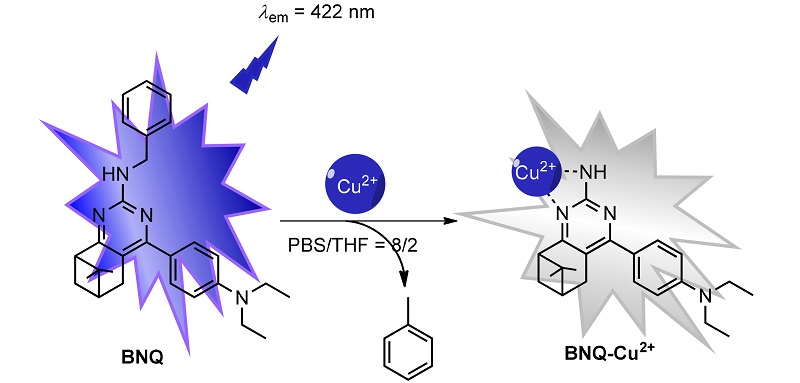摘要/Abstract

以可再生的β-蒎烯衍生物诺蒎酮为原料, 设计合成了一种新型的诺蒎酮基喹唑啉-2-胺铜离子荧光探针N-苄基- 4-(4-(二乙氨基)苯基)-7,7-二甲基-5,6,7,8-四氢-6,8-桥亚甲基喹唑啉-2-胺(BNQ). 探针BNQ在PBS/THF (V/V=8/2, 10 mmol?L–1, pH=7.4)溶液中对Cu2+表现出高度选择性的荧光猝灭效应, 并能在较宽pH范围(4~10)内有效识别Cu2+. 同时, 荧光滴定实验结果表明, 探针BNQ对Cu2+具有良好的灵敏度, 其检测限为0.09 μmol?L –1, 远低于世界卫生组织(WHO)规定在饮用水中Cu2+的最高含量(<30 μmol?L–1). 而且, 采用高分辨质谱以及密度泛函理论计算确定了探针BNQ与Cu2+的络合作用机理. 探针BNQ还可以对不同水环境中的微摩尔级Cu2+进行快速检测. 生物成像实验发现, 探针BNQ还可检测斑马鱼体内的Cu2+, 并呈现出良好的荧光成像效果.
关键词: 诺蒎酮, 喹唑啉-2-胺, 荧光探针, 铜离子, 生物成像
In this study, a novel nopinone-based quinazolin-2-amine fluorescent probe N-benzyl-4-(4-(diethylamino)phenyl)- 7,7-dimethyl-5,6,7,8-tetrahydro-6,8-methanoquinazolin-2-amine (BNQ) was synthesized from renewable β-pinene derivative nopinone. The probe BNQ exhibited a high selective fluorescence quenching response toward Cu2+in PBS/THF (V/V=8/2, 10 mmol?L–1, pH=7.4) solution, and could effectively recognize Cu2+ within a wide pH range (4~10). Meanwhile, the fluorescent titration experiment showed that the probe BNQ was high sensitive for detecting Cu2+, and its detection limit was found to be 0.09 μmol?L –1, which was much lower than that of stated by World Health Organization (WHO) in drinking water (<30 μmol?L–1). Furthermore, the coordination mechanism of probe BNQ with Cu2+ was confirmed by high resolution mass spectrum (HRMS) and density functional theory (DFT) calculations. The probe BNQ could detect micromolar Cu2+ in different environmental water samples. The results of bio-imaging experiment demonstrated that the probe BNQwas also successfully used for monitoring Cu2+ in living zebrafish, and showed an excellent fluorescence imaging performance.
Key words: nopinone, quinazolin-2-amine, fluorescent probe, Cu2+ ion, bioimaging
PDF全文下载地址:
点我下载PDF
